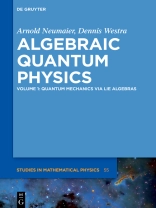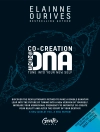This monograph introduces mathematicians, physicists, and engineers to the ideas relating quantum mechanics and symmetries — both described in terms of Lie algebras and Lie groups. The exposition of quantum mechanics from this point of view reveals that classical mechanics and quantum mechanics are very much alike. Written by a mathematician and a physicist, this book is (like a math book) about precise concepts and exact results in classical mechanics and quantum mechanics, but motivated and discussed (like a physics book) in terms of their physical meaning. The reader can focus on the simplicity and beauty of theoretical physics, without getting lost in a jungle of techniques for estimating or calculating quantities of interest.
Содержание
Preface
I An invitation to quantum mechanics
1 Motivation
1.1 Classical mechanics
1.2 Relativity theory
1.3 Statistical mechanics and thermodynamics
1.4 Hamiltonian mechanics
1.5 Quantum mechanics
1.6 Quantum field theory
1.7 The Schrödinger picture
1.8 The Heisenberg picture
1.9 Outline of the book
2 The simplest quantum system
2.1 Matrices, relativity and quantum theory
2.2 Continuous motions and matrix groups
2.3 Infinitesimal motions and matrix Lie algebras
2.4 Uniform motions and the matrix exponential
2.5 Volume preservation and special linear groups
2.6 The vector product, quaternions, and SL(2, C)
2.7 The Hamiltonian form of a Lie algebra
2.8 Atomic energy levels and unitary groups
2.9 Qubits and Bloch sphere
2.10 Polarized light and beam transformations
2.11 Spin and spin coherent states
2.12 Particles and detection probabilities
2.13 Photons on demand
2.14 Unitary representations of SU(2)
3 The symmetries of the universe
3.1 Rotations and SO(n)
3.2 3-dimensional rotations and SO(3)
3.3 Rotations and quaternions
3.4 Rotations and SU(2)
3.5 Angular velocity
3.6 Rigid motions and Euclidean groups
3.7 Connected subgroups of SL(2, R)
3.8 Connected subgroups of SL(3, R)
3.9 Classical mechanics and Heisenberg groups
3.10 Angular momentum, isospin, quarks
3.11 Connected subgroups of SL(4, R)
3.12 The Galilean group
3.13 The Lorentz groups O(1, 3), SO(1, 3), SO(1, 3)0
3.14 The Poincare group ISO(1, 3)
3.15 A Lorentz invariant measure
3.16 Kepler’s laws, the hydrogen atom, and SO(4)
3.17 The periodic systemand the conformal group SO(2, 4)
3.18 The interacting boson model and U(6)
3.19 Casimirs
3.20 Unitary representations of the Poincaré group
3.21 Some representations of the Poincaré group
3.22 Elementary particles
3.23 The position operator
4 From the theoretical physics FAQ
4.1 To be done
4.2 Postulates for the formal core of quantum mechanics
4.3 Lie groups and Lie algebras
4.4 The Galilei group as contraction of the Poincare group
4.5 Representations of the Poincare group
4.6 Forms of relativistic dynamics
4.7 Is there a multiparticle relativistic quantum mechanics?
4.8 What is a photon?
4.9 Particle positions and the position operator
4.10 Localization and position operators
4.11 SO(3) = SU(2)/Z2
5 Classical oscillating systems
5.1 Systems of damped oscillators
5.2 The classical anharmonic oscillator
5.3 Harmonic oscillators and linear field equations
5.4 Alpha rays
5.5 Beta rays
5.6 Light rays and gamma rays
6 Spectral analysis
6.1 The quantum spectrum
6.2 Probing the spectrum of a system
6.3 The early history of quantum mechanics
6.4 The spectrum of many-particle systems
6.5 Black body radiation
6.6 Derivation of Planckés law
6.7 Stefan´s law and Wien´s displacement law
II Statistical mechanics
7 Phenomenological thermodynamics
7.1 Standard thermodynamical systems
7.2 The laws of thermodynamics
7.3 Consequences of the first law
7.4 Consequences of the second law
7.5 The approach to equilibrium
7.6 Description levels
8 Quantities, states, and statistics
8.1 Quantities
8.2 Gibbs states
8.3 Kubo product and generating functional
8.4 Limit resolution and uncertainty
9 The laws of thermodynamics
9.1 The zeroth law: Thermal states
9.2 The equation of state
9.3 The first law: Energy balance
9.4 The second law: Extremal principles
9.5 The third law: Quantization
10 Models, statistics, and measurements
10.1 Description levels
10.2 Local, microlocal, and quantum equilibrium
10.3 Statistics and probability
10.4 Classical measurements
10.5 Quantum probability
10.6 Entropy and information theory
10.7 Subjective probability
III Lie algebras and Poisson algebras
11 Lie algebras
11.1 Basic definitions
11.2 Lie algebras from derivations
11.3 Linear groups and their Lie algebras
11.4 Classical Lie groups and their Lie algebras
11.5 Heisenberg algebras and Heisenberg groups
11.6 Lie-algebras
12 Mechanics in Poisson algebras
12.1 Poisson algebras
12.2 Rotating rigid bodies
12.3 Rotations and angular momentum
12.4 Classical rigid body dynamics
12.5 Lie-Poisson algebras
12.6 Classical symplectic mechanics
12.7 Molecular mechanics
12.8 An outlook to quantum field theory
13 Representation and classification
13.1 Poisson representations
13.2 Linear representations
13.3 Finite-dimensional representations
13.4 Representations of Lie groups
13.5 Finite-dimensional semisimple Lie algebras
13.6 Automorphisms and coadjoint orbits
IV Nonequilibrium thermodynamics
14 Markov Processes
14.1 Activities
14.2 Processes
14.3 Forward morphisms and quantum dynamical semigroups
14.4 Forward derivations
14.5 Single-time, autonomous Markov processes
15 Diffusion processes
15.1 Stochastic differential equations
15.2 Closed diffusion processes
15.3 Ornstein-Uhlenbeck processes
15.4 Linear processes with memory
15.5 Dissipative Hamiltonian Systems
16 Collective Processes
16.1 The master equation
16.2 Canonical form and thermodynamic limit
16.3 Stirred chemical reactions
16.4 Linear response theory
16.5 Open system
16.6 Some philosophical afterthoughts
V Mechanics and differential geometry
17 Fields, forms, and derivatives
17.1 Scalar fields and vector fields
17.2 Multilinear forms
17.3 Exterior calculus
17.4 Manifolds as differential geometries
17.5 Manifolds as topological spaces
17.6 Noncommutative geometry
17.7 Lie groups as manifolds
18 Conservative mechanics on manifolds
18.1 Poisson algebras from closed 2-forms
18.2 Conservative Hamiltonian dynamics
18.3 Constrained Hamiltonian dynamics
18.4 Lagrangian mechanics
19 Hamiltonian quantum mechanics
19.1 Quantum dynamics as symplectic motion
19.2 Quantum-classical dynamics
19.3 Deformation quantization
19.4 The Wigner transform
VI Representations and spectroscopy
20 Harmonic oscillators and coherent states
20.1 The classical harmonic oscillator
20.2 Quantizing the harmonic oscillator
20.3 Representations of the Heisenberg algebra
20.4 Bras and Kets
20.5 Boson Fock space
20.6 Bargmann.Fock representation
20.7 Coherent states for the harmonic oscillator
20.8 Monochromatic beams and coherent states
21 Spin and fermions
21.1 Fermion Fock space
21.2 Extension to many degrees of freedom
21.3 Exterior algebra representation
21.4 Spin and metaplectic representation
22 Highest weight representations
22.1 Triangular decompositions
22.2 Triangulated Lie algebras of rank and degree one
22.3 Unitary representations of SU(2) and SO(3)
22.4 Some unitary highest weight representations
23 Spectroscopy and spectra
23.1 Introduction and historical background
23.2 Spectra of systems of particles
23.3 Examples of spectra
23.4 Dynamical symmetries
23.5 The hydrogen atom
23.6 Chains of subalgebras
References
Об авторе
Arnold Neumaier and Dennis Westra, University of Vienna, Austria.












